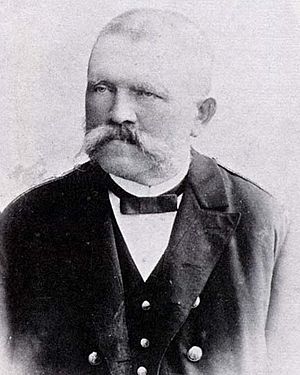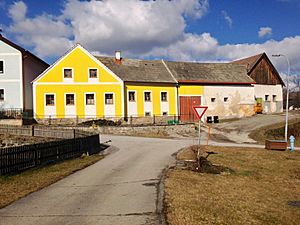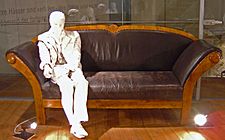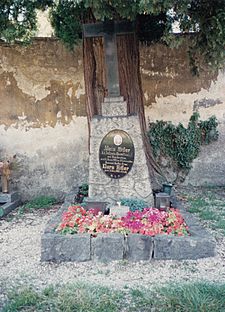Alois Hitler facts for kids
Quick facts for kids
Alois Hitler
|
|
|---|---|

Hitler in 1901
|
|
| Born |
Alois Schicklgruber
7 June 1837 |
| Died | 3 January 1903 (aged 65) |
| Resting place | Leonding's town cemetery |
| Occupation | Customs officer |
| Spouse(s) |
|
| Children | 9, including Alois Jr., Angela, Adolf and Paula |
| Parent(s) |
|
| Relatives | Hitler family |
Alois Hitler (born Alois Schicklgruber; 7 June 1837 – 3 January 1903) was an Austrian civil servant. He worked in the customs service. He is best known as the father of Adolf Hitler, who became the dictator of Germany from 1933 to 1945.
Alois Schicklgruber was born without his parents being married. His mother was Maria Schicklgruber. The identity of his biological father is not known for sure. Alois married three times during his life. His third wife, Klara, was the mother of Adolf Hitler. Alois was known to be a strict father.
Contents
Early life
Alois Hitler was born Alois Schicklgruber in a small village called Strones. This was in the area of Lower Austria. His mother, Maria Schicklgruber, was 42 years old and unmarried. At his baptism, the space for his father's name was left blank. The priest wrote "illegitimate" on the certificate.
His mother raised Alois in a house she shared with her father. When Alois was five, his mother married a man named Johann Georg Hiedler. Maria died when Alois was nine years old. By the age of 10, Alois went to live with Johann Georg Hiedler's younger brother, Johann Nepomuk Hiedler. Johann Nepomuk owned a farm in a nearby village.
Alois went to elementary school there. He also learned how to be a cobbler. When he was 13, Alois left the farm. He moved to Vienna to work as an apprentice cobbler for about five years. In 1855, at age 18, Alois joined the customs service. This was part of the Austrian Finance Ministry.
Uncertain identity of biological father
Historians are not completely sure who Alois's biological father was. Johann Georg Hiedler, who married Alois's mother, was later officially named as his father. However, some historians believe it might have been Johann Georg's younger brother, Johann Nepomuk Hiedler. Johann Nepomuk raised Alois during his teenage years. He also left Alois a large amount of money in his will.
In 1876, Alois asked for permission to use his stepfather's family name. He went to the local priest and said that Johann Georg Hiedler was his father. Three relatives, including Johann Nepomuk, were witnesses. The priest changed the birth certificate. The government then officially changed his name to "Alois Hitler" in 1877. It is not known why the name was spelled Hitler instead of Hiedler.
Career as customs official
Alois Schicklgruber started his career in the customs service. This job often required him to move to different places in Austria. By 1860, he reached the rank of Senior Warden. By 1864, after more training, he became a provisional Office Assistant. In 1875, he was an Inspector of Customs in Braunau am Inn.
His career then slowed down. It took him 17 years to get his next promotion. In 1892, he became a definite Senior Inspector of Customs. He could not go any higher in rank. This was because he did not have the necessary school degrees.
Change of surname
Alois Schicklgruber was 39 years old when he decided to change his last name. He wanted to use his stepfather's family name. He went to the parish priest in Döllersheim. He stated that Johann Georg Hiedler was his father. Johann Georg had married Alois's mother and wanted to make him his legal son.
Three relatives, including Johann Nepomuk, came as witnesses. The priest agreed to change the birth certificate. The government then officially changed his name to "Alois Hitler" in 1877. It is not known who decided on the spelling of Hitler instead of Hiedler.
Personal life
Early family life
Alois Hitler was 36 years old when he married for the first time in 1873. His first wife was Anna Glasl-Hörer. She was 50 years old and wealthy. She became ill shortly after they married.
Alois later began a relationship with Franziska "Fanni" Matzelsberger. She was a young servant at an inn where he lived. In 1880, Alois and Anna separated. Fanni Matzelsberger became Alois's partner.
In 1876, Alois hired Klara Pölzl as a household servant. She was 16 years old. Klara was related to Alois through his step-uncle Nepomuk. Fanni Matzelsberger asked Klara to find another job, so Alois sent Klara away.
On 13 January 1882, Fanni Matzelsberger gave birth to Alois's son, also named Alois. Since they were not married, the child's last name was Matzelsberger. Alois's first wife, Anna, died on 6 April 1883. The next month, Alois, 45, married Fanni Matzelsberger, 21. He then made his son legally "Alois Hitler Jr." Their second child, Angela, was born on 28 July 1883.
Fanni became very ill with a lung problem. Klara Pölzl returned to Alois's home to care for Fanni and the two children. Fanni Hitler died on 10 August 1884 at age 23. Klara Pölzl stayed in the home as a housekeeper.
Marriage to Klara Pölzl and family life
Klara Pölzl soon became pregnant with Alois's child. Alois wanted to marry Klara right away. However, because of the earlier name change, they were legally too closely related. He had to ask the church for special permission to marry.
Permission arrived from Rome. On 7 January 1885, Alois and Klara were married. The wedding was a short ceremony. On 17 May 1885, Klara gave birth to their first child, Gustav. In 1886, they had a daughter, Ida. In 1887, Otto was born but died shortly after. During the winter of 1887–1888, Gustav and Ida both died from diphtheria.
On 20 April 1889, Klara gave birth to another son, Adolf Hitler. Adolf was often sick as a child. His mother worried about him a lot. Alois was 51 when Adolf was born. He was not very involved in raising his children. He left most of it to his wife. When he was not at work, he was often at a tavern or busy with his hobby, beekeeping.
The family moved several times for Alois's job. They lived in Braunau, Passau, and Linz. On 21 January 1896, Paula, Adolf's younger sister, was born. She was the last child of Alois and Klara. Alois was often home with his family. He had five children ranging from a baby to 14 years old. Edmund, the youngest boy, died of measles in 1900.
Alois wanted his son Adolf to become a civil servant. However, Adolf did not want to follow his father's wishes. He disliked the idea of a life spent enforcing small rules. Alois tried to make Adolf obey him. Adolf, however, tried to do the opposite of what his father wanted.
Alois was described as a strict and demanding father. He expected his children to respect and obey him without question. He was known to be short-tempered.
Retirement and death
In February 1895, Alois Hitler bought a house and land in Hafeld. This was near Lambach, about 30 miles (48 km) southwest of Linz. He moved his family to the farm. He retired on 25 June 1895 at the age of 58. He had worked in the customs service for 40 years.
On the morning of 3 January 1903, Alois went to his usual inn, the Gasthaus Wiesinger. He was there to drink his morning glass of wine. He was offered the newspaper and then suddenly collapsed. He was taken to another room, and a doctor was called. However, he died at the inn. He likely died from a pleural hemorrhage, which is bleeding around the lungs. Adolf Hitler was 13 when his father died.
Removal of tombstone
On 28 March 2012, the tombstone marking Alois Hitler's grave was removed. This was also the grave of his wife Klara. The grave was in the Town Cemetery in Leonding. A descendant, an elderly female relative of Alois Hitler's first wife, removed it. She also gave up any rights to the burial plot. It is not known if the remains of Adolf Hitler's parents are still buried there.
See Also
 In Spanish: Alois Hitler para niños
In Spanish: Alois Hitler para niños
- Hitler family
Images for kids






